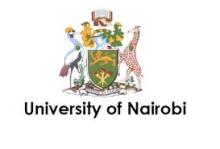Resource information
Effects of soils, vegetation and land use on infiltration
rates and related soil physical properties of the semi-arid
Sirima and Hukogodo catchments in Laikipia district were
investigated. Representative six soils in Sirima and four
soils in Hukogodo, surveyed at detailed level, were assessed.
Within soil types, four site condition treatments with respect
to vegetation cover and land use designated as Tr_ee/Bush _(TB),
Open Grass (OG), Bare Ground (BG) and Cultivated Surface (CS)
were studied. Infiltration rates were measured during a dry
and a wet season by a double cylinder infiltrometer. The top
three soil horizons bulk density, saturated hydraulic
conductivity, organic carbon, texture, antecedent water
content and water retention were also investigated .
In each catchment, within horizons, all the soil physical
parameters except texture were consistently significantly
different (p<.05) among site conditions; but rarely among
soils. Also, within soils among site conditions, the surface
horizon physical parameters exhibited significant differences
(p<.05) more often than those of subsurface horizons.
Infiltration rates were significantly different (p<.05)
among soils and site conditions in both catchments. The
difference among soils in Sirima was due to the occurence of
vertic and non-vertic ~oils; while in Hukogodo it was due to
the occu'ren ce of so iIs formed in situ and those deve loped from
alluvial material. Among site conditions, in both areas and
seasons, intake rates were highest under TB, intermediate on
OG and lowest on BG. Cultivation temporarily increased
infiltration rates above those of TB sites, however, due to
clod collapse and subsequent high susceptibility to surface
sealing , most of the increase was eliminated within a short
period.
In both areas, within each season, bulk density,
carbon
results
saturated hydraulic
significantly correlated
conductivity and
with infiltration
organic
rates and
indicate stronger surface horizon correlations relative to
subsurface horizons. All investigated parameters except clay
and silt in Sirima and clay in Mukogodo were identified in
multiple regression as significant in influencing variation in
infiltration rates.Soil cracking and swelling in Sirima during
the dry and wet season respectively, partially obscured the
influence of the physical parameters on infiltration rates.
Consistently, Sirima soils retained more water than
Mukogodo soils at all suctions, but the later had more
available water. In both areas, BG surface soils retained
significantly (p<.05) less water and also held the least
amount of available water. Cultivation reduced water
retention of surface soils, but had no significant influence
on water availability.
Depletion of vegetation due to excessive livestock
grazing and cultivation resulted in deterioration of surface
soil physical properties important in soil water intake,
storage and availability.


